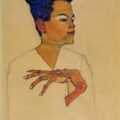Erasure, Culture, and the Working Class: On Cynthia Cruz’s Melancholia of Class

Since 2006, Cynthia Cruz’s literary output has been prolific.[1] She has published six books of poetry, two books of essays, and edited a literary anthology of Latina poets. Though her engagements with poetry, personal essays, and criticism, she has maintained a consistent focus on the working-class. In books like The Glimmering Room (Four Way Books, 2012), How the End Begins (Four Way Books, 2016), and Guidebooks for the Dead (Four Way Books, 2020), Cruz describes the lives of the working-class as they struggle through the poverty and violence of the socio-economics of neo-liberalism. Her most recent book The Melancholia of Class: A Manifesto for the Working-Class, is perhaps the closest readers have gotten thus far to understanding the origins of her development as a working-class writer and critic.
The Melancholia of Class: A Manifesto for the Working-Class can very much be read as a memoir and a manifesto urging working-class artists to incorporate more of their experiences struggling within neo-liberal society’s forces of automation, globalization, wage stagnation, and other aspects of oppression. Many of the book’s early chapters chronicle Cruz’s experiences growing up listening to music like the Jam and Joy Division, finding solace in their working-class commentary. She reflects on the life of her Mexican father, who “ran away from home when he was a teenager and joined the US as a poor or working-class Mexican American” as a way to escape his future as a farm laborer in Wyoming.
Perhaps the most insightful topic Cruz explores in these chapters is her anorexia. It’s through this topic that Cruz explores the complicated place of the working-class person in a neo-liberal society. In her chapter “The Gap Between Worlds,” she writes, “[t]he result of true anorexia (not dieting to fit society’s norms) is to set one’s self apart. It is to become indigestible to the capitalist system. The anorexic rage made manifest.” In many ways, anorexic becomes a valuable symbol for the working-class—it agitates the neo-liberal order, it refuses compromise.
Cruz elaborates on additional modes of agitation analyzing the punk ethos and aesthetic. Punk “is a symbol of a sneer, of refusal. They are also not interested in compromise, not about to protest or write letters to politicians.” Like anorexia, punk is a form of annihilation linked to the Freudian death drive. These forms of annihilation are the most direct response to neo-liberalism’s austere plans for the working and poor classes as these forms of annihilation work to disrupt the process of assimilation of the working-class. Punk and anorexia do this by utter refusal to negotiate. The anorexic’s intent in their refusal, Cruz writes, is to confuse the idea that “thinness appears as conformism” and to instead “become indigestible to the capitalist system.” Cruz recounts various points in her own life when she observed annihilation in one form or another, “[b]y the time I left my hometown for college, most of the working-class kids I’d known were dead or had gone missing.” Cruz meditates on the working-class dilemma of choosing her path in early adulthood. A life in her hometown would guarantee the annihilation that took many of the people she grew up with. But moving away risks a similar possibility—the death of her working-class identity, an identity that was authentic and original to her then.
Cruz returns to this insight often when analyzing the lives and output of numerous artists in The Melancholia of Class. Sometimes these artists are able to transcend this key conflict relatively unscathed, however, more often than not, the artist experiences an existential tragedy in one form or another. They have been caught between the worlds of the working-class and the middle or upper-classes. Each artist desires to find a place where their work can be recognized in terms of their merit and identity. However, as the artist’s career becomes more accomplished, it becomes apparent that traditional market success requires them to lose a sense of their original self. In chapter five, for example, Cruz uses the psychoanalytic theory of the libidinal to illustrate how Amy Winehouse’s climb to stardom or assimilation also resulted in her figurative and literal loss of self. For Cruz, the libidinal is an energy that is “[i]indistinguishable from the death drive, it gains momentum and velocity in its circuitous drive after the object of its desire.”
Early in Winehouse’s career this libidinal energy was captured in her unmistakable stage presence and ability to create highly emotional lyrics. However, as gossip magazines began to hound her for refusing a “Pygmalion transformation” from her working-class identity, Winehouse began to spiral into drug use and anorexia. Like many of the artists Cruz discusses, Winehouse is described as being trapped in a complex predicament created by neo-liberal society where success as a working-class artist doesn’t exist, and what the capitalist system is offering is not something Winehouse had any interest in consuming. Winehouse “was an incredibly gifted singer, writer, and musician,” Cruz writes, “but the world didn’t know what to do with her. Her complexities were too diverse.”
Cruz’s commentary on melancholia and the acknowledgement of the working-class’s existence in neo-liberal society provide perhaps the most insightful passages of The Melancholia of Class. Cruz begins with Freud’s definitions of mourning and melancholia as “the sufferer griev[ing] the loss of a loved object.” What is unique about melancholia, however, is that the lost object becomes “a loved object and a hated one” although “what or who has been lost is unclear.” Contemporary society’s denial of the working-class’s existence, in Cruz’s analysis, prompts the melancholia of working-class individuals. She poignantly observes, “the world I now live in, an overwhelmingly middle-class one, and the working-class world I grew up in. What I lost, haunts, because as it was happening (as my working-class origins were being lost), I did not experience it.” She argues that the working-class exists as a form of the death drive because neo-liberal society will not acknowledge it, leaving the working-class “to return to its origin, to destroy everything in order to begin again.” Perhaps the primary purpose here is more than allowing the individual to revisit their origin. It’s a way of rescuing their working-class self from erasure by those in power and, in doing so, gaining agency over their own identity.
The world of working-class literature is incredibly diverse, perhaps it’s because the working-class society it reflects is so diverse. One final observation Cruz makes is about the notion of “slickness” and “authenticity” in working-class art where—because of pressures from editors and producers—the working-class artist “has forsaken who she was for a shiny, alternative version of herself.” Indeed, many can see the results of slickness in books and films like Winter’s Bone or Hillbilly Elegy where characters and the situations they find themselves in are often over-romanticized. To a borrow a term from director Barbara Loden, “everything turns to Formica.” Readers would gain more insight reading the books of working-class writers published by university and small presses, where pressures are less driven by market forces and profit motives.
The most ambitious aspect of the text is Cruz’s goal of getting working-class artists and individuals to “claim our place in the class struggle” in order to “help clarify the truth of our experience and awaken us to what is actually happening.” In example after example, Cruz embodies that engagement with that struggle. In The Melancholia of Class: A Manifesto for the Working-Class, we find an author who exemplifies what it means to be dedicated to one’s art and to be a rallying voice for those whose identities are excluded and erased by the neo-liberal ethos and its cultural power brokers.
[1] Cynthia Cruz has been a contributor to The Critical Flame since 2015. Rick Joines reviewed her 2014 collection Wunderkammer in Issue 33. –Ed.
About Daniel Mendoza
Daniel Manuel Mendoza is a writer and critic living in the Rio Grande Valley. His work has appeared in Boulevard, American Book Review, and Texas Review. He is the author of Stray Dogs: Interviews with Working-Class Writers (Down & Out Books, 2016).





